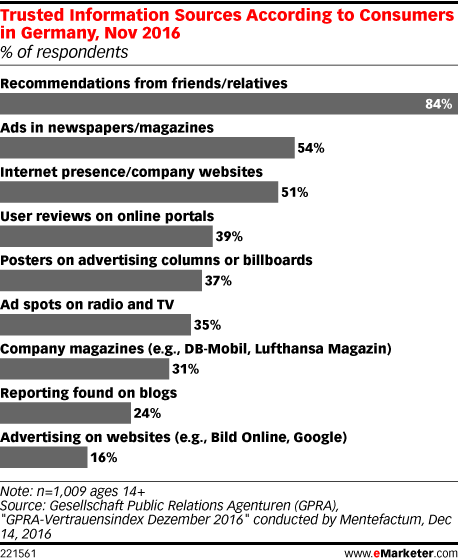
Last week I saw an interesting graph by eMarketer.com, showing ‘Trusted Information Sources’. It clearly shows that people trust print ads (in newspapers/magazines) much more than digital ads (on websites): 54% vs 16%… So why are CMO’s still shifting the larger part of their (often limited) budget to digital? To that less trusted information source? Probably accountability: people tend to think that you can’t get a good reporting on the effect of printed ads. But au contraire my friend! It’s easy, very easy… I’ll show you how.
CONTENTS: Trusted information sources | Step-by-step… | Why is this important? | Update
But first the graph by eMarketer.com. It is based on the German ‘GPRA Vertrauensindex’.

The most trusted information source, with a big lead, is of course ‘friends/relatives’ (84%). But the second one is ads in newspaper/magazines (54%), which has a much higher score than digital ads (16%), which is the least trusted source in the list. Could it be that people trust newspapers and magazines in general more than websites and therefor also trust ads in those mediums more than on websites? Or is it because it is harder and more expensive to produce ads in newspapers and magazines? Whatever the reason: it’s a very significant difference. It’s such a big difference that advertisers, brand owners should take it into account.
Of course, these figures are only from Germany, you could argue that they are not completely representative for the rest of the world… But over the past few years, multiple studies have found differences between paper and digital communication. E.g. this article from Forbes gives a really good overview. And here is also another interesting article about a study conducted by Temple University. A few weeks ago a study by SUMO Heavy found that advertising and sponsored content on social media influence less than 16% of social media users…
Step-by-step…
So the signs are all over the place: print ads do have an important place in the marketing mix. But how can you connect that offline medium to your digital reporting system? It’s quite easy.
Step 1: create a landing page
The first step is the same step you will take when creating a digital ad: create the landing page on your website. E.g. https://www.insights4print.ceo/my-fantastic-landing-page-for-that-great-tutorial/ Now that URL isn’t that easy to remember, so we really need to add an extra step.
Step 2: create short URLs
If you want to put a URL into a printed ad, you better have a short and easy to remember URL, because people will have to type it into a browser. E.g. http//www.insights4print.ceo/ads201701. Later we will create a ‘redirect page’ that will redirect visitors of the short URL to the landing page with the long URL.
If you want to put the printed ad in different publications, you could opt to create multiple short URL’s, e.g. for ads in The New York Times, Wall Street Journal and USA Today. That could look like this:
https://www.insights4print.ceo/NYT201701
https://www.insights4print.ceo/WSJ201701
https://www.insights4print.ceo/USA201701
This way you can later track in your web statistics from which publication the visitors came! Great, isn’t it? You don’t need to create different landing pages for each publication: the different short URLs will be the entry point on your website and will be visible in your statistics.
And in the future you can use variations of these short URLs: if you want to run a second ad in the New York Times in February, the short URL could be: https://www.insights4print.ceo/NYT201702.
There are also ‘URL shortener’ services available, e.g. Bitly. These can be very helpful in some cases, but I wouldn’t use these in an ad: they are way to abstract, way to difficult to remember… And there might be a (big) cost involved, certainly if you want a fancy one. More information on URL shorteners can be found here.
Step 3: create the redirects (please check update below!)
Before you can go live with these short URLs, you need to create ‘redirects’ from the short URLs to the actual landing page with the long URL. It might look complex, but it really isn’t. I can do it, so you can do it to.
The redirect is a short piece of HTML-code. It tells the browser to go to another page, after a specified amount of time. In this cause, the amount of time would be zero (although in reality there might be a short delay).
That code looks like this:
<meta http-equiv="refresh" content="0"; url=https://www.insights4print.ceo/my-fantastic-landing-page-for-that-great-tutorial/" />
The web development team can insert that code into the pages with the short URLs.
In case you have to create these pages manually, it will look like this:
<html> <head> <meta http-equiv="refresh" content="0; url=https://www.insights4print.ceo/my-fantastic-landing-page-for-that-great-tutorial/"> </head> </html>
This code needs to be saved as a html-page, meaning: you have to name it like this: NYT201701.html. Now you need to put this in the root directory of your website (your web development team can help you with that). And you need to use that URL, including the .html in the ad.
Be sure to test it first, before you go live!
Step 4: create the link from print to digital
The fourth step is to put the link into the printed ad. The simplest way is to just put the short URL in the ad: https://www.insights4print.ceo/NYT201701. And put a call to action next to it! “Get your special offer today: https://www.insights4print.ceo/NYT201701”, for example. Plain and simple.
You could use more fancy tricks to link the printed ad to the landing page, but beware: you and I are way ahead of the curve. It’s not because we know how to use that brand new and fancy stuff, that your target audience will know how to use it. QR-codes might already be known by a lot of people, but if you go to really specialized tricks, the average consumer will not know it. And the average user will not take the time, nor do the effort, nor even care to find out how that fancy new technology works. Yes, you read the instructions, I read the instructions, but again: we are both ahead of the curve. So unless you want to reach your peers, the tech savvy guys/girls: don’t use fancy stuff that nobody knows about! Just use the plain and simple stuff, just mention a URL that is easy to remember.


If you use a QR-code, make sure that the landing page is mobile friendly… Everybody will scan the QR-code with a smart phone. And there is nothing more irritating then being welcomed with a page you can’t read on your mobile device. And also make sure the QR-code is not too complex: a short URL will result in less and bigger small squares in the QR-code, a long ULR means much more and much smaller small squares in the QR-code. Make it easy to read, don’t make it too small!
Step 5: check your web statistics!
You’re all set now… You just need to check your web statistics, just like you would normally do. Since the viewers of the print ad enter via a specific URL (the short ones we’ve created in step 2), you will get a really detailed view of people taking action after seeing the printed ad in a specific publication. And since they did go online, you can track the complete journey they took on your website, just like you do with people coming in via a digital ad… There is no more distinction between ‘print’ users and digital users, you are tracking them both the same way.
Why is this important?
Many CMO’s shift budgets to digital, to online because it is very easy to get reports and prove ROI. Much easier than with traditional media. But printed ads are trusted much more than digital ads, there value is higher, they have a higher ROI according to some studies, they have a different impact on our brain. With a few simple steps, one that every marketing department can take, you can get the results from printed ads into your reporting system. And get a better, more complete picture of marketing ROI. You might be surprised!
UPDATE 11/04/2017: it seems there is a much better way to handle the redirects (step 3). I’ve explained it in a new blog post, which also explains how you can get ‘print’ into Google Analytics! And, as a bonus, it tells you how you can create your own branded URL shortener almost for free… Check it out!


Many times I have seen the same thing: a company has revised the proportions of expenditure in advertising communications – removed outdoor and glossy advertising and transferred that money to the Internet.
The result – a significant drop in sales, and a partial decline in confidence in the brand.